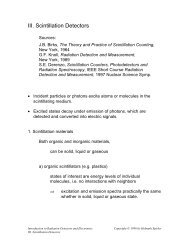Introduction to radiation-resistant semiconductor devices and circuits
Introduction to radiation-resistant semiconductor devices and circuits
Introduction to radiation-resistant semiconductor devices and circuits
You also want an ePaper? Increase the reach of your titles
YUMPU automatically turns print PDFs into web optimized ePapers that Google loves.
Again, we see substantially less post-<strong>radiation</strong> degradation in the PMOS<br />
<strong>devices</strong>. One can also observe the higher intrinsic noise of NMOS short channel<br />
<strong>devices</strong>. Although the observed degradation is quite small in some cases, typically<br />
it is quite substantial <strong>and</strong> would need <strong>to</strong> be compensated for by a considerably<br />
higher operating current. Seller et al. have exposed low-noise preamplifiers fabricated<br />
in a rad-hard 1.2 μm bulk CMOS process <strong>to</strong> a dose of 100 Mrad <strong>and</strong> measured<br />
noise <strong>and</strong> gain. (37) Gain decreased by no more than 7%, but the increase in<br />
equivalent input noise at high frequencies ranged from 20 <strong>to</strong> 75%. This process is<br />
only specified <strong>to</strong> 5 Mrad, so these results indicate that <strong>circuits</strong> are still quite usable<br />
at much higher doses, if one can accommodate the increase in noise.<br />
Due <strong>to</strong> the presence of mobile trapped charge, threshold behavior can become<br />
quite difficult <strong>to</strong> predict when the gate voltage changes appreciably with varying<br />
duty cycles, as in logic circuitry. Detec<strong>to</strong>rs <strong>and</strong> analog circuitry are simpler by<br />
comparison, since the voltage levels are either static or change with a fixed period,<br />
as in analog pipelines, for example. In general, when performing ionization damage<br />
tests <strong>devices</strong> must be operated at typical operating voltages <strong>and</strong> digital circuitry<br />
must be clocked at frequencies <strong>and</strong> patterns approximating typical operation.<br />
Generally speaking, both bulk <strong>and</strong> SOI (silicon on insula<strong>to</strong>r) CMOS are subject<br />
<strong>to</strong> the effects described above. SOI is often cited as a specifically <strong>radiation</strong>-hard<br />
technology because of its resistance <strong>to</strong> transient <strong>radiation</strong> effects, primarily latchup<br />
due <strong>to</strong> pho<strong>to</strong>currents developed at high intensity bursts of <strong>radiation</strong><br />
(>10 6 -10 7 rad/s) typical of nuclear de<strong>to</strong>nations. Although SOI can provide<br />
superior device speed because of reduced stray capacitance, this technology is not<br />
inherently more <strong>resistant</strong> <strong>to</strong> <strong>radiation</strong> in our applications. If anything, the additional<br />
oxide interfaces tend <strong>to</strong> complicate matters <strong>and</strong> at this time most <strong>radiation</strong>-<strong>resistant</strong><br />
CMOS processes are on bulk silicon.<br />
Radiation Effects in Integrated Circuit Structures<br />
The preceding discussion has emphasized the properties of individual <strong>devices</strong>.<br />
In integrated <strong>circuits</strong> many <strong>devices</strong> are placed close <strong>to</strong>gether. As mentioned above,<br />
the silicon surface is naturally n-type, so isolation structures are required <strong>to</strong><br />
preclude unwanted cross-coupling between <strong>devices</strong>. Two basic techniques are<br />
used:<br />
• junction isolation, where reverse-biased pn junctions provide both ohmic <strong>and</strong><br />
capacitive isolation.<br />
• oxide isolation, where oxide layers with carefully controlled interface<br />
properties deplete the adjacent silicon of mobile charge.<br />
19





